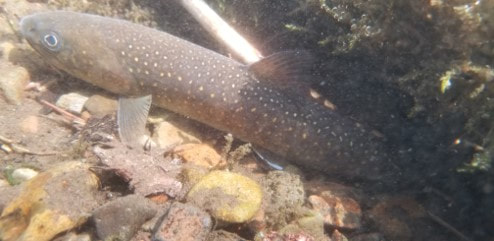BULL TROUT (SALVELINUS CONFLUENTUS) RECOVERY FACEs MULTIPLE CHALLENGES:
|
Brook trout (Salvelinus fontinalis) outnumber bull trout 60:1 in certain reaches of the Upper Malheur. Brook trout compete for limited resources (habitat and food) and negatively impact bull trout reproductive efforts by hybridizing. Currently, the overwhelming population of introduced brook trout in the Upper Malheur (Lake Creek) is the biggest threat to the local bull trout population. (See BPT Annual Reports at www.cbfish.org) |
#1 Invasive Brook Trout |
|
|
#2 Climate Change: Rising stream temperatures Bull trout require cold streams. When compared to other native fish species bull trout are extremely sensitive to rising temperatures. Warm water temperatures create thermal barriers which restrict movement. |
|
#3 Habitat Degradation
Bull trout require Cold, Clean, Connected, and Complex streams. Poor land management practices (legacy effects from the past as well as ongoing practices) negatively affect bull trout populations. Poor land management practices can include: over-grazing in riparian habitat and dewatering. BPT is actively restoring riparian habitat at several different locations. |
|
#4 Shrinking Populations
Warming stream temperatures and dewatering reduce both available habitat and connectivity between habitats. Limited movement leads to small populations and lack of overall genetic variation. Degraded habitat and poor water quality cause a decline in bull trout populations BUT can be tolerated by invasive brook trout. Restoration and thoughtful land management practices are powerful methods in bull trout conservation, however managing non-native fish is the current focus for bull trout recovery in Upper Malheur. |
Want to know More?
AboutThe Help Native Fish educational materials were created in 2018 to raise awareness about what people who live, work, and recreate near riparian areas can do to help native fish. Currently the materials have been implemented throughout Eastern Oregon.
Our teamThe Technical Advisory Committee of the Malheur River Working Bull Trout Group includes Oregon Department of Fish and Wildlife, Bureau of Reclamation, US Fish and Wildlife Service, the US Forest Service, and the Burns Paiute Tribe. The Technical Advisory Committee is coordinated by the Burns Paiute Tribe Natural Resources Department.
|
Questions about what you can do or want to learn more?
Contact the fisheries manager at the Burns Paiute Tribe by using the contact form below. |









